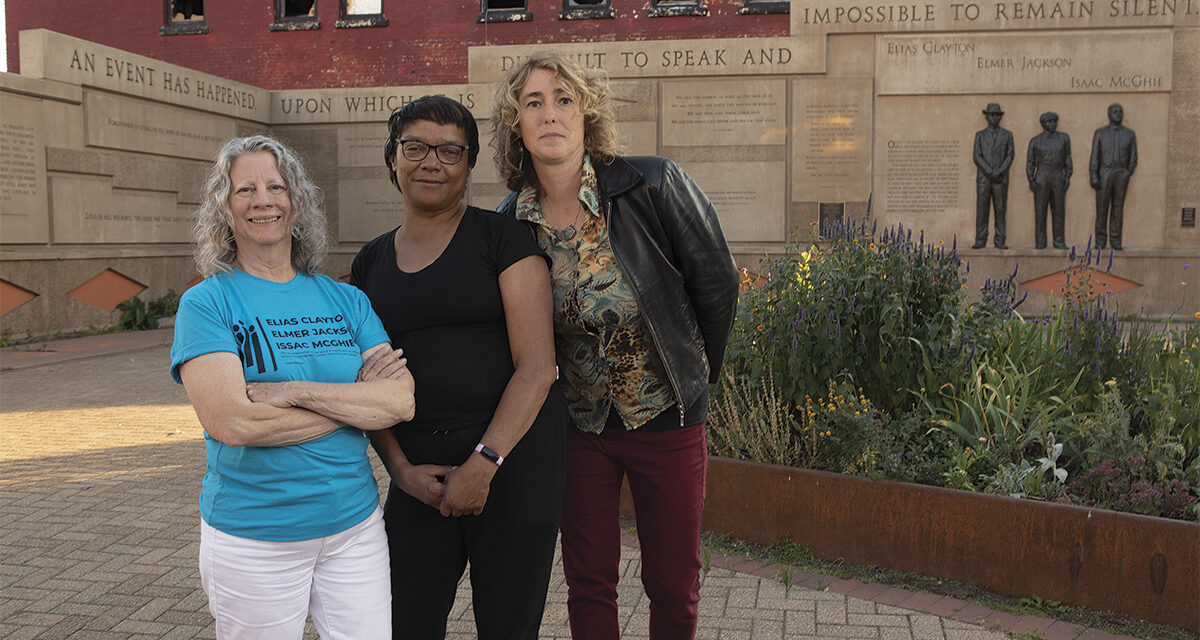
(l-r) Susan Ault, Kim Green, and Catherine Nachbar at a memorial in Duluth at the site where three young Black men were lynched in 1920. Ault has been on the memorial board for 10 years. Green is co-chair of the memorial committee. Nachbar was a founding board member and has been a Duluth public school teacher for 26 years. Photo Sarah Whiting
On June 15, 1920, Elmer Jackson, Elias Clayton, and Isaac McGhie — three young Black men — were lynched in downtown Duluth.
A white woman named Irene Tusken alleged that six circus laborers sexually assaulted her at gunpoint when she was leaving the circus grounds. Six men were arrested and jailed by the Duluth police based on vague descriptions, and a white mob — estimated between 5,000 and 10,000 — formed outside the Duluth city jail. They used bricks, rails, and heavy timbers to force their way into the building, then dragged Jackson, Clayton, and McGhie to a light pole on the corner of First Street and Second Avenue. The mob beat the men and lynched them one after another.
A photo was taken of members of the mob posing in front of the bodies; these were sold as a postcard. The next day the Minnesota National Guard arrived to secure the three accused who remained in the jail.
Over the following weeks, a grand jury issued 37 indictments for rioting and participating in murder. Eight men were tried, four were acquitted, one trial ended in a hung jury, and three were sentenced — ultimately serving less than 15 months in prison. No one was convicted of murder.
Nearly 20 percent of Duluth’s Black population left the city over the next decade. Those who stayed formed the Duluth branch of the NAACP. Nellie Francis, a Black activist from Saint Paul, led the campaign at the Minnesota legislature for a state anti- lynching law, signed in 1921.
It is widely believed that the assault was a fabrication. A physician who examined Tusken the morning after found no physical signs of rape or assault. Years after her death, a family member reported to an inquiring university student that Tusken had lied about the incident.
For decades, Clayton, Jackson, and McGhie’s bodies lay in unmarked graves in Duluth’s Park Hill Cemetery. In 1991, their graves were honored with headstones inscribed: “Deterred but not defeated.”
Twenty years ago, a permanent memorial was erected across the street from the site of the lynching. The site is stewarded by the Clayton Jackson McGhie Memorial Committee, which holds a remembrance for the victims every year on June 15. Minnesota Women’s Press spoke to members of the committee’s board about how this history was resurrected and is remembered today.
On a culture of secrecy
Kim Green: I was born and raised here, and I didn’t know about this story until I was 18. I have met so many people who grew up and went to school here — and I’m talking about Black people in this community — who did not know that happened.
My relatives told me about it; I never learned it in school. My grandmother and grandfather came here [in the 1940s] and worked at the steel mill. My uncles and aunts have said that in the Black community, in the 1950s and 1960s especially, Duluth was known as a sundown town [meaning white people would use the threat of intimidation or violence to keep non-white people fearful of leaving their homes after dark]. We’re still [experiencing racism here]. But we, this organization, try to stay encouraged to keep getting the word out. The board members keep me encouraged.
Susan Ault: I was 60 years old when I found out about it. The Minnesota History Theater did a performance in 2005, and I learned from watching that.
Even for people here in Duluth, with relatives who know the story because they lived it — it was such a secret.
Catherine Nachbar: The lynching was something I heard about from my father. I didn’t believe him, so I asked my ninth-grade civics teacher about it. He said, “Yep, that is true. We don’t know much about it.” I asked, “Are we gonna learn about it?” He said, “No, it’s not in the curriculum.” I remember looking at him and saying, “That seems really important.” He said, “Well, Catherine, that’s just not part of this class.”
That moment has resonated with me for a long time; it is one of the things that led me to my career as a teacher.
On the resurrection of history that led to the memorial
SA: The men had been buried in unmarked graves with the assistance of one of the churches in town. That was done on the quiet, and the location of the graves remained a secret until the story started to be told in the 1990s.
CN: I started teaching tenth-grade history at Central High School in 1997 when I was 21. When I was looking at what to teach during those first years, I picked up Michael Fedo’s book. It is now called The Lynchings in Duluth, but at the time it had a different title. [Editor’s Note: Michael Fedo’s historical account of the lynchings was originally titled They Was Just Niggers, a quote from a mob member. Published in the 1970s, it was the first book written about this history.]
I went to speak with an administrator to see if I could get approval to use it. Vance Hopkins was vice principal at Central High School, one of the few administrators of color in Duluth. I knocked on his door and gave him the article, and he said, “Are you asking me if students should read this
because I’m a Black man?” I was afraid he might fire me. Instead he said, “I appreciate that you’re bringing this into the classroom. But I want you to take the title off when you make photocopies of this. It’s important that the language isn’t moving through the hallway without some understanding of what this is about.” So that’s what I did. The students read it.
Around the year 2000, a local historical writer, Heidi Bakk-Hansen, was researching a story about the lynchings for a local paper called the Duluth Rip-Saw. She went to a skate park to ask [kids there] if they were learning about the event in school. The students she talked to happened to be in my class, so she contacted me.
The article contained a call for people to meet at the corner where the lynchings happened to support the placement of a permanent memorial. We talked about wanting to do more to bring awareness.
SA: They were able to get a concept together for a memorial and raised money quickly. The city became a major partner and purchased the land that the memorial is on. The original board members laid the stones of the memorial.
These young men should have been college bound or career bound, so in addition to stewarding the physical memorial, each year since 2003 the organization has given out two or three scholarships in the range of $1,000 to $2,000 to BIPOC students who are interested in post-secondary education and racial equity.
On curriculum
CN: In the early 2000s, Heidi and I worked with a group of students who were interested in learning more about the event after hearing about it in class. We met before school and dug into Minnesota Historical Society records. We were able to find in the phonebook where Irene Tusken had lived. We looked at where the jurors lived and found that they were prominent names at that time, [and some are associated with] businesses that are still here. It became pretty emotional; some of the students have family connections to the names we found. Some of the materials that we discovered were eventually used in the classroom curriculum.
In 2008, the school board endorsed teaching about the lynching. The original curriculum books [created by me and University of Minnesota Duluth professor David Beard] are lost at this point, but there are many online resources teachers can use today.
It is a difficult topic, and people’s background knowledge, content knowledge, and comfort level for bringing these topics into the classroom vary.
Minnesota state standards for 10th-grade history include the topic of lynchings, but it’s up to interpretation which benchmarks [specific concepts or events] are going to be used for meeting the standards.
When we talk about lynching in the past, it is important for us to see these parallels to the present. This generation of students is very different from when I started because of what they’re seeing around them. When we go into this history, you often can hear a pin drop in the classroom. I think that you need a day just for processing and hearing about the history. That second day, you’re going to make some parallels to the present, and then you need a third day for meaningful dialogue.
SA: The memorial foundation has spent some time trying to [ensure that every student in Duluth public schools is taught about the lynching]. It goes around in circles: “You have to talk to the [teachers] union about that. You need to talk to the Social Studies Department about that. You need to talk to the admin about that.”
Sundown
KG: BIPOC people in this community and in this state are still racially profiled. I experience racism at least three times a week — a cashier might try not to touch my hand to give me my change back, petty stuff like that. But I am encouraged by my cousins and my aunts and uncles who are still here, and encouraged when we can gather together and talk openly about the issues that are going on in this community.
SA: As the white person looking in, who’s been involved with African American communities in other areas, I’m struck by how there isn’t really an African American community center or neighborhood in Duluth.
KG: My daughter brings that up, about how there’s no place for us to gather and get engaged with each other. [That was] a lot of the reason why she left Duluth. That’s a big challenge this organization is working on.
CN: When we look at our graduation rates, accumulated wealth, statistics of racial profiling, I think [people need to] take the time to recognize that the viciousness that took place is not past tense.
The hesitancy to acknowledge what happened is also an important part of this story. When we shut down truth, and we ban access to information, it historically doesn’t go well. It is a constant reminder, when I drive by [the memorial], or if I’m having discussions in a classroom, of how important it is that we hear different voices and perspectives, and we don’t shut down something because we don’t want to hear it.
Resources
“Duluth’s Lingering Shame,” by Heidi Bakk-Hansen in the Duluth Ripsaw







